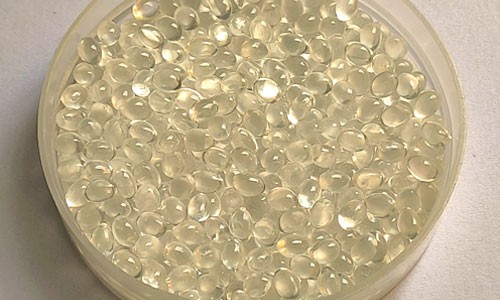
Composition of EVA Hot Melt Adhesive
EVA hot melt adhesive is a solid, solvent-free, water-free fusible polymer. It is solid at room temperature and melts into a flowable, viscous liquid adhesive when heated to a specific temperature.
The melted EVA hot melt adhesive appears as a light brown translucent or natural white (when titanium dioxide is added) bonding material. It is composed of a base resin, tackifier, viscosity modifier, antioxidant, and other components.
Base Resin
The base resin of EVA hot melt adhesive – EVA resin – is a copolymer of ethylene and vinyl acetate polymerized under high temperature and high pressure. EVA resin is the primary component for making hot melt adhesive. During formulation, it typically constitutes 40% to 60% of the adhesive, depending on the required ratio. The proportion of the base resin determines the fundamental properties of the hot melt adhesive, such as bonding strength, melting temperature, and the selection and formulation of additives. These properties vary with the proportion of the base resin. Therefore, the EVA hot melt adhesive used in bookbinding should be selected based on the needs of the materials being bonded, choosing a variety with appropriate softness, elasticity, adhesion, and minimal deformation for formulation.
Tackifier
The tackifier is one of the main additives in EVA hot melt adhesive. Relying solely on the base resin, it only possesses bonding strength when melted at a certain temperature. Once the temperature drops, the bond becomes weak or even fails entirely, making it difficult to wet and penetrate paper effectively, thus preventing an ideal bonding result. To enhance bonding performance, tackifiers – substances that can co-melt with the base resin – are incorporated. Adding an appropriate amount of tackifier to EVA hot melt adhesive also improves the fluidity of the adhesive, enhancing its ability to wet and penetrate the substrate, improving bond strength, and meeting the strength requirements for books and booklets. Tackifiers are generally selected from rosin derivatives and terpene resins, typically constituting around 15% to 20% of the formulation.
Viscosity Modifier
The viscosity modifier is another key additive in EVA hot melt adhesive. Its function is to reduce the melt viscosity, increase fluidity and wettability, and regulate the setting speed to achieve rapid and strong bonding.
Antioxidant
The adhesive can undergo oxidative decomposition when melted due to high temperatures. Adding an appropriate amount of antioxidant prevents premature aging of the EVA hot melt adhesive.
Cold-Resistant and Heat-Resistant Agents
EVA hot melt adhesive is a thermoplastic bonding material with strict requirements for the operating environment during use. Adding a cold-resistant agent prevents premature reduction of the adhesive's open time and setting time caused by low temperatures in winter. (Note: The original text mentions "抗寒剂" (cold-resistant agent) but doesn't explicitly mention a heat-resistant agent for high temperatures, though the section title implies it. The translation reflects the content provided.)
Characteristics of EVA Hot Melt Adhesive
Fast Curing, Easy Storage: EVA hot melt adhesive is solid at room temperature and melts into a liquid adhesive when heated to a specific temperature. Upon cooling below its melting point after removal from the heating device, it rapidly solidifies again (hardening back into its original solid state). As the adhesive generally has a relatively high melting point (typically around 80°C), it remains in block form at room temperature, making packaging simple and storage easy.
Low Pollution Hazard, Strong Adhesion: EVA hot melt adhesive has a slight odor when melted into a liquid. Equipment is usually equipped with devices to absorb odors, so it poses no harm to humans. Furthermore, due to its high melting point, there is no risk of adhesive leakage causing environmental pollution. The adhesive layer of EVA hot melt adhesive exhibits both a degree of flexibility and a certain level of hardness after application.
Re-tackifying Property: The adhesive layer of EVA hot melt adhesive applied to a substrate, once cured or cooled and hardened, can be softened again by heating above its melting point. As the adhesive temperature increases, it becomes liquid again, restoring its tackiness.
Ease of Use: To use EVA hot melt adhesive, simply place the adhesive blocks into a container, heat them until melted, and bring the liquid adhesive to the required viscosity.
 HOT LINE: 086-577-65159218
HOT LINE: 086-577-65159218












